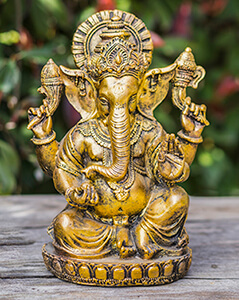
Ganesha Meaning
Stories of a Beloved Hindu God
Ganesha meaning reveals the amazing qualities of one of the most well-known and popular deities in the Hindu pantheon. Also known as Ganapati or Lord Ganesh, he is the colorful and memorable elephant-headed son of Shiva and Parvati. This deity is commonly believed to be the ruler of new beginnings, and the master of removing to success.
Share this page with a friend!

Who Are the Parents of Ganesha?
Ganesha’s mother Parvati and his father Shiva have very different personalities. Parvati is loving and devoted. Shiva is austere and fierce. Some legends suggest that they had a disagreement about whether or not to have children. As a result of this disagreement, Shiva and Parvati separated.
Separation of Parvati and Shiva
During their long separation, Parvati realized that she could create a child for herself without Shiva’s assistance. After all, she is a goddess. In this version of the story, Parvati breathed into the foam in her bath. Her son Ganesha appeared. At the time, Ganesha had the appearance of a normal boy.
Ganesha As Parvati’s Defender
As Ganesha grew up, he became his mother’s defender. Shiva had been absent a long time and many suitors were coming to the palace door. One day Shiva himself appeared. Not knowing his son (clearly his paternity can be debated), he thought that someone had taken his place.
Shiva Kills Ganesha
Shiva immediately challenged Ganesha, attacked him and cut off his head. Clearly, this reckless murder was a huge obstacle interfering with Shiva’s quest to reunite with Parvati. Realizing his horrendous error, Shiva ran into the forest.
Shiva Brings Ganesha Back to Life
Shiva saw an an old elephant in the forest. Fortunately, the elephant was a Shiva devotee. The elderly elephant offered to assist him. When Shiva explained the situation, the elephant allowed himself to be sacrificed. Shiva rushed back to the palace and magically joined the elephant’s head to the body of his son, thereby bringing Ganesha back to life.
Watch nearly 400 videos on the Vocal Medicine Channel!
Ganesha Meaning: Overcoming Obstacles
The story of Parvati and Shiva’s separation and reunion explains why Ganesha is viewed as the overcomer of obstacles. By magically fusing the elephant head to his son’s body, Shiva brought his son back to life. In this way, Shiva overcame the seemingly insurmountable obstacle of his son’s death that would have blocked his reunion with Parvati.
Ganesha and New Beginnings
This was a new beginning for the entire family. In fact, Ganesha received his new name after undergoing this ordeal and transformation. Interestingly, although he is known for removing obstacles, Ganesha sometimes places obstacles in the path of those who need to be checked.
Watch nearly 400 videos on the Vocal Medicine Channel!
Sweetest Ganesha Story Ever
There was an argument among the gods in heaven: which of the sons of Shiva and Parvati was the wisest? Shiva and Parvati have two sons and one daughter. One son is Kartikeya. Kartikeya has a normal human form. The other son is Ganesha, who has an elephant’s head and an enormous body. (They also have a daughter, Akosha Sundari, but she is not part of this story.)
Brahma Offers a Golden Mango
Shiva and Parvati went to Brahma, the creator god, for the answer to the question on their sons’ relative intelligence. Brahma does not answer the question but sends his own son Narad to offer a golden mango to Shiva and Parvati. He also sends the message that whoever eats the mango will be granted immortality and supreme knowledge.
A Competition for Immortality
Shiva and Parvati set up a contest for one of their sons to win the mango as a prize. The son who circles the world three times first will prove himself and gain immortality. Each of the gods and goddesses have typical animals that they ride. Ironically, Ganesha rides a mouse (or rat) while the slim Kartikeya rides a mythical animal similar to a peacock. Ganesha realizes that he has no chance to win by conventional means. He comes up with an alternate plan.
Ganesha Views His Parents Symbolically
The starting gun goes off and the race begins. Kartikeya takes off at top speed. Ganesha begins to ride his mouse around where his parents are standing. They look at him in confused concern. He continues to ride around them three times. At the end, he announces, “You, my parents, are my entire world. I have just ridden around my world three times.”
Ganesha Wins the Race
They are touched with his sentiment and impressed with his ingenuity. Ganesha wins the race, the golden mango, his parent’s appreciation, and his own immortality. Ganesha has proven himself to be the wisest son of Shiva and Parvati.
Author Kathleen Karlsen
Kathleen Karlsen is a musician, artist, writer and speaker. She is the author of two books (Flower Symbols and Vocal Medicine) and over 200 articles. Kathleen, her husband Andrew, and their five children live in Bozeman, Montana. More about Kathleen Karlsen.
GANESHA MEANING ARTICLE SUMMARY
Ganesha is well-known in the East as an aspect of God to appeal to at the beginning of new endeavors. He is the Hindu god of overcoming, a fusion of an elephant head and a human body. This article covers the origins of Ganesha and stories that illustrate Ganesha meaning for devotees of East and West.



